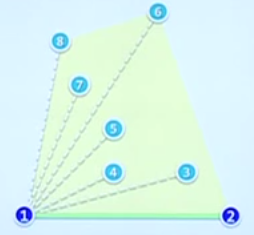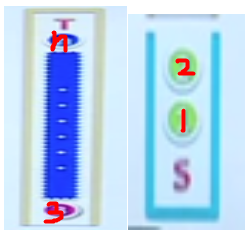graham算法是先要对顶点进行预处理:
首先通过找到起始点LTL,然后其他点按照与起始点间极角的大小排序。

然后我们利用两个堆栈来对点集中的点进行操作,先是初始化:

之后我们会对T逐个元素的扫描看其是否为极点,每次扫描后都会让问题的规模线性减少,也就是必然有一个堆栈中的一个元素被剔除(判断为非极点),最终栈S中剩下的元素就是逆时针排放好的极点集合。
代码实现:
#include <iostream>
#include <vector>
#include <map>
#include <stack>
#include <algorithm>
#include <graphics.h>
#include <time.h>
#include <conio.h>
using namespace std;
#define POINTNUM 10
struct Point
{
double x; // x坐标
double y; // y坐标
double z; // z坐标(默认为0,如果需要三维点则给z赋值)
Point(double a = 0, double b = 0, double c = 0) { x = a; y = b; z = c; } // 构造函数
};
Point sub(const Point& lhs, const Point& rhs)//向量减法
{
Point res;
res.x = lhs.x - rhs.x;
res.y = lhs.y - rhs.y;
res.z = lhs.z - rhs.z;
return res;
}
Point div(const Point& p, double ratio)//向量除法
{
Point res;
res.x = p.x / ratio;
res.y = p.y / ratio;
res.z = p.z / ratio;
return res;
}
double length(const Point& vec)//向量长度
{
return (sqrt(pow(vec.x, 2) + pow(vec.y, 2) + pow(vec.z, 2)));
}
Point normalize(const Point& vec)//向量标准化
{
Point res;
res = div(vec, length(vec));//向量除以向量长度
return res;
}
double dotMultiply(const Point& vec1, const Point& vec2)//向量点乘
{
return(vec1.x * vec2.x + vec1.y * vec2.y + vec1.z * vec2.z);
}
Point multiply(const Point& vec1, const Point& vec2)//向量叉乘
{
Point result;
result.x = vec1.y * vec2.z - vec2.y * vec1.z;
result.y = vec1.z * vec2.x - vec2.z * vec1.x;
result.z = vec1.x * vec2.y - vec2.x * vec1.y;
return result;
}
// 参数: vec1 矢量1 vec2 矢量2
double Cos(const Point& vec1, const Point& vec2)//向量余弦
{
Point unit_vec1 = normalize(vec1);
Point unit_vec2 = normalize(vec2);
return dotMultiply(unit_vec1, unit_vec2);
}
//利用行列式的几何意义,通过判断正负来判断点在直线向量的左侧还是右侧
int Area2(Point a,Point b,Point c){
return a.x*b.y-a.y*b.x+b.x*c.y-b.y*c.x+c.x*a.y-c.y*a.x;
}
bool ToLeft(Point a,Point b,Point c){
return Area2(a,b,c)>0;
}
// 参数: points : 平面点集
//
vector<Point> findConvexGraham(const vector<Point>& points)
{
vector<Point> result;
// 点的数量必须大于三个
if (points.size() < 3)
return result;
// 寻找最底部的点(LTL)
int index = 0;
for (int i = 0; i < points.size(); ++i)
{
if (points[i].y < points[index].y ||(points[i].y == points[index].y && points[i].x < points[index].x))
{
index = i;
}
}
Point convex_p = points[index];
// 计算每个点的极角
map<double, int> cos_map;
Point x_vec(1.0, 0.0);
for (int i = 0; i < points.size(); ++i)
{
if (i != index)
{
double cos_value = Cos(sub(points[i], convex_p), x_vec);
// 如果有多个点有相同的极角,则取最远的点
if (cos_map.count(-cos_value) != 0)
{
if (length(points[i]) > length(points[cos_map[-cos_value]]))
cos_map[-cos_value] = i;
}
else
cos_map[-cos_value] = i;
}
}
// 保存结果的栈
stack<int> result_stack;
// 存入开始的两个点
result_stack.push(index);
result_stack.push(cos_map.begin()->second);
for (auto iter = (++cos_map.begin()); iter != cos_map.end(); ++iter)
{
int first = result_stack.top();
result_stack.pop();
int second = result_stack.top();
Point vec1 = sub(points[first], points[second]);
Point vec2 = sub(points[iter->second], points[first]);
//判断当前点是否在上一条极边的左侧还是右侧
//if (ToLeft(points[second],points[first],points[iter->second]))
if (multiply(vec1, vec2).z>0)//在左侧则保留上一极点
result_stack.push(first);
result_stack.push(iter->second);
}
// 将数据从栈中读取
while (!result_stack.empty())
{
result.push_back(points[result_stack.top()]);
result_stack.pop();
}
std::reverse(result.begin(), result.end());
return result;
}
int main()
{
vector<Point> points;
initgraph(600,600);//创建一个600*600的窗口
srand((unsigned)time(NULL));//产生随机种子
for(int i=0;i<POINTNUM;i++){//随机生成10个点
Point point;
point.x=rand()%600;
point.y=rand()%600;
points.push_back(point);
setlinecolor(RGB(255,0,0));
setfillcolor(RGB(255,0,0));
fillcircle(point.x,point.y,3);
}
vector<Point> result=findConvexGraham(points);
//画出结果
int len=result.size();
for(int i=0;i<len-1;i++){
setlinecolor(RGB(0,0,255));
line(result[i].x,result[i].y,result[i+1].x,result[i+1].y);
}
setlinecolor(RGB(0,0,255));
line(result[len-1].x,result[len-1].y,result[0].x,result[0].y);
getch();
closegraph();
return 0;
}
然而这个实现还是有问题的。。。。:

不知道为什么,总是有一个点会莫名其妙被算入极点。希望有大神可以解答






















 789
789











 被折叠的 条评论
为什么被折叠?
被折叠的 条评论
为什么被折叠?








